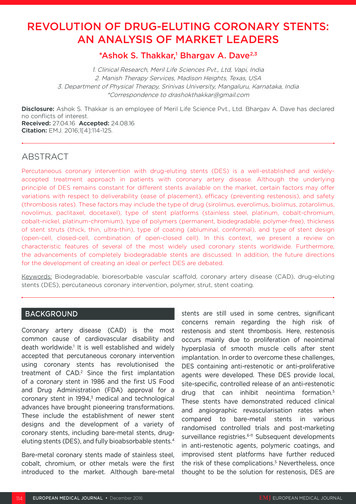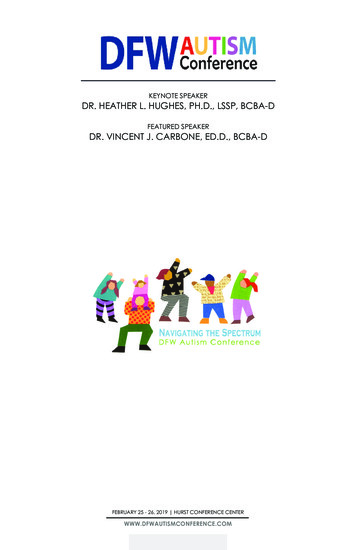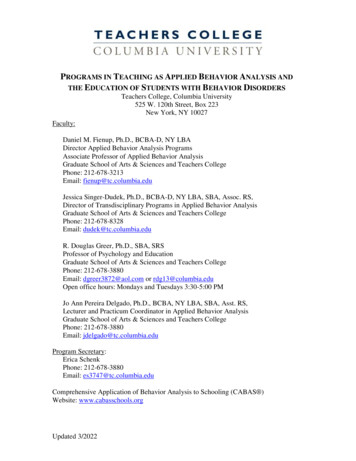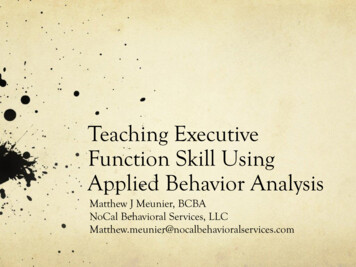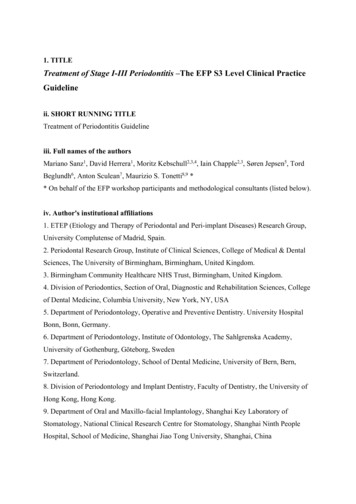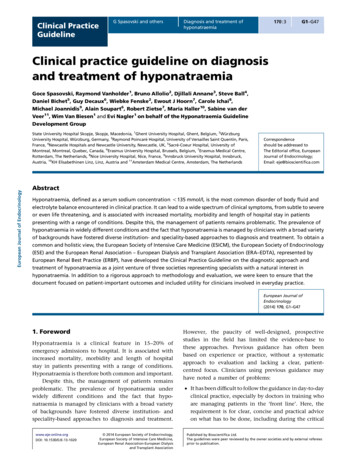
Transcription
EUROPEAN JOURNAL OF BEHAVIOR ANALYSIS2010, 11, 207 - 216NUMBER 2 (WINTER 2010)207Emerging Opportunities in Higher Education:Applied Behavior Analysis and AutismShahla Ala’i-Rosales1, Lise Roll-Pettersson2, Sarah Pinkelman3, and Traci Cihon1University of North Texas, 2Stockholm University & Akershus University College, and 3University of Oregon1The growing number of children diagnosed with autism and the recognized importance of evidencebased interventions has substantially increased the need for well-trained applied behavior analysts.Relative to public/consumer demand, there are very few higher education programs that are equippedto train behavior analysts specializing in autism. Worldwide, there are only a few programs accreditedby Association for Behavior Analysis International (ABAI), that have course sequences approved bythe Behavior Analysis Certification Board (BACB), and have formal institutional course approval forclasses in autism and behavior analysis. The purpose of this paper is to introduce a series of expertcommentary on the context, content and systems required to build quality higher education programsin autism and applied behavior analysis. Together the articles in this special section of the EuropeanJournal of Applied Behavior Analysis form a resource for faculty and university administrators interestedin the development of innovative and socially relevant training programs in higher education.Key words: applied behavior analysis, higher education, autismThe Center for Disease Control (CDC,2007) recently identified the increase in autismas an “urgent public health concern” (2007).In an analysis of epidemiological studies acrosstime and cultures, Fombonne (2005) notedan increase in prevalence figures within thelast 20 years: between 1966 and 1993 themedian prevalence figure was 4.7 per 10,000and in the period between 1994 and 2004, themedian rate was 12.7 per 10,000. In 2007,The CDC Autism and Developmental Disabilities Monitoring Network reported thatapproximately 1 in 150 8-year-old children invarious areas of the United States had an Autism Spectrum Disorder. Similar internationalfigures have been reported. For example, inSweden reports indicate prevalence of 6.2 in1000 children (Fernell & Gillberg, 2010) andin China rates of 16.1 per 10,000 (Wong &Hui, 2008). Across the globe, it is agreed thatgrowing societal awareness, better detection,A Behavior Analysis Online grant from the University ofNorth Texas supported preparation of this manuscript. Correspondence may be directed to Shahla.Alai-Rosales@unt.eduor to Lise.roll-pettersson@specped.su.se.and broadening of diagnostic criteria contribute to the increase in the number of childrendiagnosed with autism (e.g., Rutter, 2005).At this point in time, there is no knowncause, and no known cure for autism (Geschwind, 2009). There are, however, a numberof procedures and treatment models derivedfrom the field of Applied Behavior Analysis(ABA) that are effective in teaching important skills, reducing challenging behavior anddramatically improving the quality of life forpeople with autism (c.f., Meyers & Johnson,2007; National Standards Project, 2009).Unfortunately, there is an alarming shortage ofpeople trained to understand, implement andindividualize these procedures (c.f., McGee &Morrier, 2005; Scheurmann, Webber, Boutot,& Goodwinl, 2003).The increase in cases of autism combined withthe shortage of trained ABA professionals constitutes a serious problem for individuals with autism, their families and for society. It is estimatedthat the financial costs associated with untreatedor ineffectively treated individuals range from 656,000 to 2.5 million over the course of207
208Shahla Ala’i-Rosales, Lise Roll-Petterson, Sarah Pinkelman, and Traci Cihona lifetime (Jacobson, Mulick, & Green, 1998;Jarbrink & Knapp, 2001) and can cost at least 208,500 per child during eighteen years ofschooling (Chasson, Harris, & Neely, 2007).Such estimates do not even begin to factor thehuman costs and suffering faced by people withautism and their families. Multiply such costsby the estimated number of individuals acrossthe globe that are not receiving treatment andan “urgent health concern” becomes a crisis.Generally, societal agencies, such as institutions of higher education, only allocate theirlimited resources to new activities when thereis a crisis. In a crisis the contingencies result inimmediate pressure to “change” in some way inorder to avoid aversive stimulation or to increaseaccess to reinforcement (Risley, 2001). Withinhigher education, the crisis contingencies willlikely involve resource allocations, rankingsand accreditations, and complaints or praise byimportant constituencies. If behavior analystsare able to help universities gain access to reinforcement to avoid aversive stimulation, crisistreatment availability in combined with globalmovements in higher education present highereducators in behavior analysis with some promising opportunities for the training of appliedbehavior analysts.For example, increased funding is availableto institutions of higher education for trainingautism personnel in the behavioral treatmentof autism, to conduct research to study theeffectiveness of interventions, and for trainingleadership personnel with strong behavior analytic skills (c.f., US National Institutes of Health,2010). There is also an increasing public demandfor trained behavior analysts (and strong complaints when they are not available), particularlyin the area of early intervention. In many places,governmental or third party health care coverageis increasing (e.g., Bouder, Spielman, & Mandell, 2009). Furthermore, graduate programsthat enable students to sit for certification aregrowing at an unprecedented rate (Hughes &Shook, 2007). Demand and funding create opportunities for university faculty. Under suchconditions, faculty and administrators haveleverage created by societal need to support boldprogram creations and innovations.There is another movement that may beof importance to behavior analysts in highereducation: Universities are increasingly beingcalled upon to justify their activities as sociallyrelevant (e.g., Association of American Collegesand Universities, 2007; European Associationfor Quality Assurance in Higher Education,2010). Towards that end, leaders in Europeanhigher education emphasize the contributionsof flexible and dynamic “knowledge triangles”,that is, the beneficial interactions and outcomesthat can occur between education, research andinnovation (Jacobsson, 2009). In the summarystatement of a recent conference supported by theEuropean Commission, the conveners stated thatunder conditions of crisis the funding of highereducation, especially research and innovationshould be increased rather than reduced. Thiswould be particularly true when the “triangle”being funded involves close partnerships andinnovative problem solving between universitiesand industry (Jacobsson, 2009). Furthermore,the premium is on applied rather than theoreticalresearch and on efforts and resource allocationsthat meet modern demands on higher education(Nayyar, 2008). Higher education is in searchof creative and adaptable ways to survive andto respond to the crises presented by a world inconstant cultural and technological disruption.This, too, is a leverage point for program developers. Since its inception, Applied BehaviorAnalysis has engaged in bold actions to predictand produce behavior change that results in meaningful and valued outcomes. From the beginning,this scientific experimental approach has produced innovative ways of exploring, understanding, and improving the human condition (c.f.,Baer, Wolf & Risley, 1968/1987; Goldiamond,1965; Lutzker & Martin, 1981). The motivatingoperations in place for creative advances in highereducation programs in Applied Behavior Analysisand autism. It was the recognition that the present conditions are opportunities that led to, first,the “Texas Summit” and second, the completionof this special section. During the process ofteaching and striving to improve the education ofbehavior analysts we can develop new methodologies and innovations in both higher education andin autism intervention.
Emerging Opportunities in Higher EducationConvening Participants: The TexasSummitIt is our hope that as conditions unfold within institutions of higher education around theworld, the faculty in departments of behavioranalysis or related disciplines will have resourcesto create or expand programs. This special section is an effort towards that end. In Septemberof 2010, a group of area experts, stakeholdersand generalists were invited to contemplate,discuss and debate matters related to the trainingof autism interventionists. We specifically askedsome of the participants to prepare thoughtfulcommentary regarding targeted areas: professional expectations, content matter, and highereducation methods. These were people that haddemonstrated mastery and expertise in the areathey were asked to address. Other participants,parents of people with autism and students ingraduate programs in autism, were asked tolisten to presentations, meet and consort withthose providing commentary and to formallyand informally give the summit organizers (theauthors) feedback on the topics addressed.The “Texas Summit” convened for two days,involving presentations and large and smallgroup discussions. After the meeting, each areaexpert was asked to formally submit a manuscript for inclusion in this special section. Eachmanuscript underwent a peer review process byat least two scholars with area expertise. Whatthe reader views in this special section is theculmination of the contributions of the areaexperts, the stakeholders, and the peer reviewers.Professional ExpectationsThe first two articles provide the reader withan understanding of professional knowledgeand performance expectations in the field ofbehavior analysis and autism. Weiss and Shook(this issue) present an overview of the development and process of identifying knowledge andskills documented to be important for behavioranalysts specializing in autism interventions.The authors very eloquently describe the needto protect consumers from unskilled or inappropriate interventions. They suggest one ofthe most important avenues to insure benefit209and prevent harm is through comprehensiveand high quality training requirements andcertification of behavior analysts. Weiss andShook describe inventories of educationalexperiences developed by the Association forBehavior Analysis International (ABAI), theABAI Autism Special Interest Group, and theBehavior Analysis Certification Board (BACB).It should be noted that these inventories haveserved as a guide for the handful of programsalready offering some degree of specialized training in behavior analysis and autism. For example,Table 1 provides an overview of the graduate curriculum in the Department of Behavior Analysisat the University of North Texas. In it are the corecurricular content areas required by ABAI andthe BACB as well as the course and performancecontent recommended by the ABAI Autism SIG.The work described by Weiss and Shook providesa blueprint for building this kind of curriculum inbasic principles and practices of behavior analysisas they apply to autism intervention.Green (this issue) extends Weiss and Shookby offering a point of emphasis that is inherent in the world view of behaviorism butthat is frequently neglected in the arena ofprofessional training: “scientific attitude”.That is, Green presents a clear argument forstrengthening the role and practice of scientificmethod in higher education training of interventionists. This is especially true in a climate whereboth valid research and quackery are proliferating at exponential rates. The newly educatedbehavior analyst must be trained to discriminate,navigate, and evaluate claims and findings in waysthat will rely on scientific knowledge and inquiry.In this way, as they make decisions about whatand how to intervene, they will do so with agreater degree of integrity and assurance.Curricular ContentWith regard to curricular content, twoareas required special attention: 1) skills students can learn to effectively support families and 2) skills required to implement andsupervise Early and Intensive BehaviouralInterventions (EIBI). Both of these areas havea growing research base. They are also twoareas where the consequences are profound.
210Table 1. A Curricular ExampleShahla Ala’i-Rosales, Lise Roll-Petterson, Sarah Pinkelman, and Traci CihonTable 1. A Curricular ExampleUniversity of North Texas,Department of Behavior AnalysisCore BA CurriculumRequired Courses BEHV 5000 Observation andMeasurement of Behavior andEnvironment BEHV 5100 Respondent and OperantConditioning BEHV 5010 Experimental Analysis ofBehavior BEHV 5020 Theory and Philosophy inBehavior Analysis BEHV 5140 Research Methods inBehavior Analysis BEHV 5150 Techniques in AppliedBehavior Analysis BEHV 5250 Quantitative Methods inBehavior Analysis BEHV 5250 Stimulus Control BEHV 5250 Functional Analysis BEHV 5330 Verbal Behavior BEHV 5540 Legal, Ethical andProfessional Issues in Behavior Analysis BEHV 5560 Development of BehaviorIntervention Programs BEHV 5570 Training and Supervisionof Staff in Human Service SettingsChildren and their families can suffer orflourish as a result of the quality of intervention. The two articles in this part are designedto provide the reader with curricular directionsthat should target interventionist skills thatresult in high quality interventions.Mayville and Letso (this issue) providea description of content specific knowledgeand skills related to families and to community participation across the lifespan. Thisincludes information on training domains,assessment and intervention goals, behaviorAutism Specialty AreaRequired Courses BEHV 5028 Applied Behavior Analysis& Autism: Methodological andConceptual Issues BEHV 5029 Applied Behavior Analysis& Autism: Research and PracticePerformance Requirements BEHV 5810 Practicum in Autism I BEHV 5815 Practicum in Autism II BEHV 5815 Practicum in Autism III BEHV 5820 Internship in Autism BEHV 5950 Thesis in AutismProfessional PortfolioArea DescriptionsWork SamplesSupervisory EvaluationsSelf EvaluationsElective CoursesAdditional courses within theDepartment of Behavior Analysis andacross the university (e.g.,Instructional Design, ChildDevelopment, OrganizationalBehavior Management, BehavioralPharmacology, AppliedAnthropology)change procedures, and the identification andmanagement of variables affecting meaningfulfamily and community life. As they remindus, the question, “Does what we are teachingmatter?” is most profoundly apparent in thecontext of a person’s family and community.They offer suggestions as to how our studentscan identify and address valued outcomes (bythe person with autism, the family, and thecommunity). They present this informationwithin a lifespan perspective, covering earlychildhood to adulthood.
Emerging Opportunities in Higher EducationOne area within the lifespan, early childhood, warrants extended attention. An increasingly robust body of research supports EIBI.However, behavior analysts with sophisticatedand complex repertoires produced the dramaticfindings demonstrated in EIBI research. In thispart, one of those researchers, Eikseth, describesthe array of theoretical and clinical knowledgethat a well-trained EIBI professional shouldhave in order to produce outcomes similar tothose found in the EIBI research. As he pointsout, the task analysis of what to train studentsin higher education is still largely experientialrather than evidence-based. However, it is alsoimportant to note that evidence-based practice isthe combination of research evidence and clinical wisdom (Geddes & Harrison, 1997). Untilthere are more studies of the professional trainingcurriculum targets, the clinical wisdom of highlyexperienced scientist-practitioners will provide uswith an advantageous starting point.Higher Education MethodsWhile the first two parts present a landscapeof “what” to train future interventionists, the finalpart provides the reader with perspectives andinformation on “how” to train. Three vantagepoints were included here: utilizing technology,performance engineering, and promoting facultyexcellence.First, Roll-Petterson, Alai-Rosales, Keenanand Dillenburger (this issue) provide us with anoverview of how new technologies can improvethe quality and effectiveness of higher educationtraining programs. This includes blended use ofmedia, distance, and engineering technologies toestablish and maintain behavioral repertoires forstudents in university settings. The number andtypes of new technologies available are astonishing and bring promise of accessible and effectiveeducation for many, many behavior analysts.Roll-Petterson and colleagues stress that thefoundational elements of good university instruction (humane, student centered, outcome basedteaching) be held at the forefront as faculty learnto incorporate an increasingly diverse and largenumber of new technologies. They also point outthat the technologies hold promise for both essential knowledge and intervention performance.211Ingvarsson, Cammileri and Smith (thisissue) provide us with a detailed analysis ofthe systems and techniques that produce reliable and high quality performances in adultlearners. The authors describe the theory andresearch on establishing and maintaining repertoires in behavior analysts serving childrenwith autism and their families. They articulatethe importance of providing performancebased training to students in higher education.Performance-based training presents uniquechallenges to higher education, as the procedures to produce these repertoires are typicallynot found in lecture halls. Fortunately, theauthors provide a wealth of resources documenting effective methods and systems thatdo provide high quality performance-basedtraining.These first six articles provide new ordeveloping programs rich resources for thestandards and content of training curriculafor advanced professional training in behavioranalysis and autism intervention. Our finalarticle by Bernstein and Dotson (this issue)speaks specifically to the faculty member andoffers clarifications and suggestions for promoting teaching excellence. They begin with adescription of the levels of understanding thatare required of behavior analysts working in autism intervention and then examine pedagogical methods that have been shown to producesome of these repertoires. They place a specialemphasis on teaching “deep understanding” andflexible and adaptive problem solving skills thatproduce innovators and contributors to effectiveand meaningful autism interventions. They endwith a call to increase scholarly examination ofteaching practices by providing descriptions andresults that are visible to other higher educatorswithin and outside of behavior analysis.Ongoing DialoguesThroughout the Texas Summit and theactivities leading up to this special section wehave asked colleagues to discuss, comment,criticize, as well as review article drafts. Aswith any scientific discipline some inner contemporary tensions and challenges emerged.
212Shahla Ala’i-Rosales, Lise Roll-Petterson, Sarah Pinkelman, and Traci CihonThe inclusion of inner disciplinary dialogues isan important component to achieving critical thinking skills, deep understanding, andproblem solving in higher education. Instructors can use these dialogues to help students understand how the content they arelearning fits with other sources of knowledgeand action. Three specific topics repeatedly surfaced amongst summit participants:disciplinary identity, interdisciplinarity, andglobalization.Disciplinary IdentityWhat is ABA? A source of tension existsabout our disciplinary identity. Within thisdiscussion it is helpful to understand howdisciplines as a general class are defined. Inthe broadest sense, they are self-referentialcommunities, evolving for the purpose of establishing rules for inclusion in a specific community, for delineating the subject matter ofthat community, for instructing the methodsof inquiry, and for describing the approachesto training within the disciplinary culture(Weingart, 2010). Of course, the boundariesof any given discipline are subject to changeand evolution and, while a discipline may beviewed from the outside as a coherent whole,internal debates about what gets included andwhat does not get included often occur (Frodeman, 2010). For these reasons we would liketo talk about the general definitions of ABAand then point out some of the contemporarytensions.As we understand it, ABA is a branch ofa natural science, behavior analysis, whichstudies behavior-environment interactions.In the case of ABA, the methods of scientificinquiry valued by the broader disciplinarycommunity are employed as a means tounderstanding and improving conditions forhumans and other living creatures. ABA ischaracterized by: 1) directly observable andquantifiable subject matter; 2) evidence thatexperimental intervention variables are reliably effective in changing socially importantbehaviour; 3) operational descriptions ofbehaviours and procedures; 4) conceptually coherent integration of proceduralfindings with basic principles and knowledgeof behaviour (Baer, Wolf, & Risley, 1968).The content areas of ABA are broad and diverseand include autism as well as many other content areas of importance. For example, behavioranalysts have conducted work in the areas ofenvironmental sustainability (e.g., Lehman &Geller, 2004), behavioral medicine (e.g., Wadden & Foster, 2000), industrial safety (e.g.,Mattilla, Rantanen & Hyttinen, 1994), equinecare (Ferguson & Rosales-Ruiz, 2001), sportspsychology (e.g., Lacy & Goldston, 1990), and,of course, autism intervention (e.g., Matson &Smith, 2008).Where do the tensions lie? There are at leasttwo sources of difficulty. While some version ofthe above is what many applied behavior analystsmight describe, one tension appears to be aboutthe way we talk about ABA. Many Summit participants report an increase in talking and actingabout ABA as if it is an intervention procedurerather than a scientific process. For example,a casual search of the Internet will reveal manyinstances of equating ABA with a particular setof procedures or models (usually discrete trialinstruction with children with autism) and having limited generality (such as ABA is only forparticular learners). Some of this verbal behavioremanates from non-professionals, but also appears to be demonstrated by people who havecompleted higher education training programsin the discipline. Furthermore, there are cases oflitigation (e.g., Choutka, Doloughty, & Zirkel,2004) and scholarly commentaries in journals(e.g., Callhan, Shukla-Mehta, Magee, & Wie,2010) in which the relative merits of doing“ABA” versus a particular model or procedurehave been argued. In keeping with Baer, Wolfand Risley (1968), we would not “do ABA”in an intervention, per se. ABA is an appliedscience, a process, which allows us to discoverwhat procedures or collections of proceduresare effective or not effective.It is not clear why there is confusionabout the nature of ABA. Is it hard to describe a process? Is marketing or countermarketing responsible for the change in theway our discipline is described? Or, is ourdiscipline in the process of redefining itself?
Emerging Opportunities in Higher EducationWhatever the reason, the tension and thepossible ways of communicating about it andunderstanding it is important and should bedirectly addressed in our disciplinary trainingprograms.Along the same lines, the relationship between our science and our practice has risento a boiling point, as illustrated by a recentABAI presidential column. In this commentary, Friman (2010) reflects on recent eventsand ponders the status of ABAI as a scienceorganization, the possibilities of it an evolving into a practice-based organization, andthe need to safeguard the science of behavioranalysis. He goes on to suggest that one of themore important activities of ABAI is to ensure,through the accreditation process, that scienceis an important part of behavioral educationalcurricula; in fact, “science and education arehandmaidens to each other, and both serveand shape practice” (5). The tension is not anew one. It is part of the reason for the largermovement of scientist-practitioner models thatbegan with the 1949 Boulder conference (Baker& Benjamin, 2000), and was central to publicdebates within behavior analysis in the 1980s(see Baer, 1981; Malott, 1981; Michael, 1980)and the 1990s (Baer, 1992; Johnston, 1996;Malott, 1992; Reid, 1992). This topic, too,will require surveillance and inclusion withinbehavioral higher education programs.InterdisciplinarityAutism is a pervasive disorder that affectsevery part of life (American Psychiatric Association, 1994; World Health Organization,2007). This means that, by necessity, manyother disciplines will be involved in providingservices to people with autism and their families. Furthermore, many other disciplines willbe involved in trying to understand and solvethe puzzle of autism. For the behavior analystsin training, this means that for the well-beingof the people we serve we must find productiveways of collaborating and working with otherdisciplines (Idol, Nevin, & Paolucci-Whitcomb,1994). There was frequent discussion amongSummit participants regarding the importanceand the difficulty that this entails.213The taxonomies of interdisciplinarity arenumerous and evolving (Klein, 2010).Twotypes of interdisciplinarity will be describedhere: casework and communication (Krohn,2010). Interdisciplinary casework involves activities related to solving specific problems (e.g.,a speech language pathologist and a behavioranalyst designing a communication intervention). Interdisciplinary communication involvesinformation sharing and stimulation betweenresearchers and/or practitioners devoted toa particular area (e.g., early identification ofautism might involve behavior analysts, speechpathologists, pediatricians, nurses, public healthprofessionals, etc.). Such collaborations are increasingly important and useful. In any case, theskills needed to successfully participate in thesevenues are teachable and important to includein professional training programs (Chen, Klien& Minor, 2009).GlobalizationWe live in an age of disruption and constantchange. Recognized by universities all over theworld, this fact requires contemplation and innovative actions on the part of higher education(Nayyar, 2008). It also requires self-awarenessin terms of how one’s discipline and work fitwithin the greater context of globalization.There appear to be at least three main pointshere: 1) Behavior analysis is a collective sciencewith wide generality across cultures and contentareas; 2) from its inception, behavior analysishas placed itself within the values of globalsustainability and humane outcomes (Skinner,1953); and 3) there are methods to effectivelyincrease collaborations across cultures and wecan teach our students to do this (Karlburg,2010). At this point in time, we are presentedwith an opportunity to support the science ofbehaviour on a global level (Hughes & Shook,2007). The Texas Summit and the resultingspecial section are perhaps one indicator thattraining efforts will contribute to some level ofglobal generality. Participants were professionals and students from diverse parts of the world.Many of them spoke to both the strengths anddifficulties of implementing behavioural interventions within and across different cultures.
214Shahla Ala’i-Rosales, Lise Roll-Petterson, Sarah Pinkelman, and Traci CihonThis included issues related to access to services(very limited in some parts of the world), training content (sometimes culturally incongruentgoals and methods), and resources (limited ordisciplinarily restricted funds).As we engage in efforts such as this Summit,we make progress. We are forming culturallyadaptive curriculum content, are using technologies to increase access and address disparities, are refining methods to effectively teachthat curriculum and are having internationaldialogues about how that fits with what elsewe know. This special section of The EuropeanJournal of Behavior Analysis reflects one of several actions designed to move our training andour meaningful global impact one step further.ReferencesAmerican Psychiatric Association (1994). Diagnostic and Statistical Manual of MentalDisorders. Washington, DC: AmericanPsychiatric Association.Association of American Colleges and Universities, The National Leadership Council forLiberal Education and America’s Promise.(2007). College Learning for the New GlobalCentury. Washington, DC: Association ofAmerican Colleges and Universities.Baer, D. M. (1992). Teacher proposes, studentdisposes. Journal of Applied Behavior Analysis, 25, 89-92.Baer, D. M., Wolf, M. M.& Risley, T. R.(1968). Some current dimensions of applied behavior analysis. Journal of AppliedBehavior Analysis, 1, 91-97.Baer, D.M (1981). A flight of behavior analysis. The Behavior Analyst, 4, 85-91.Baker, D.B. & Benjamin, L.T. (2000) Theaffirmation of the scientist-practitioner,American Psychologist, 55, 241-246Bernstein and Dotson (2010) PromotingTeaching Excellence in Professional Education of Behavior Analysts, European Journalof Behavior Analysis, 11, 277-288Bibby, P., Eikeseth, S., Martin, N. T., Mudford,O. C., & Reeves, D. (2001). Progress andoutcomes for children with autism receiving parent-managed intensive interven-tions. Research in Developmental Disabilities, 22, 425-447Bouder, J.N., Spielman, S. & Mandell, D.S.(2009) Brief report: Quantifying the impactof autism coverage on private insurance premiums, Journal of Autism and DevelopmentalDisorders, 39, 953-9
Key words: applied behavior analysis, higher education, autism A Behavior Analysis Online grant from the University of North Texas supported preparation of this manuscript. Cor-respondence may be directed to Shahla.Alai-Rosales@unt.edu or to Lise.roll-pettersson@specped.su.se.
